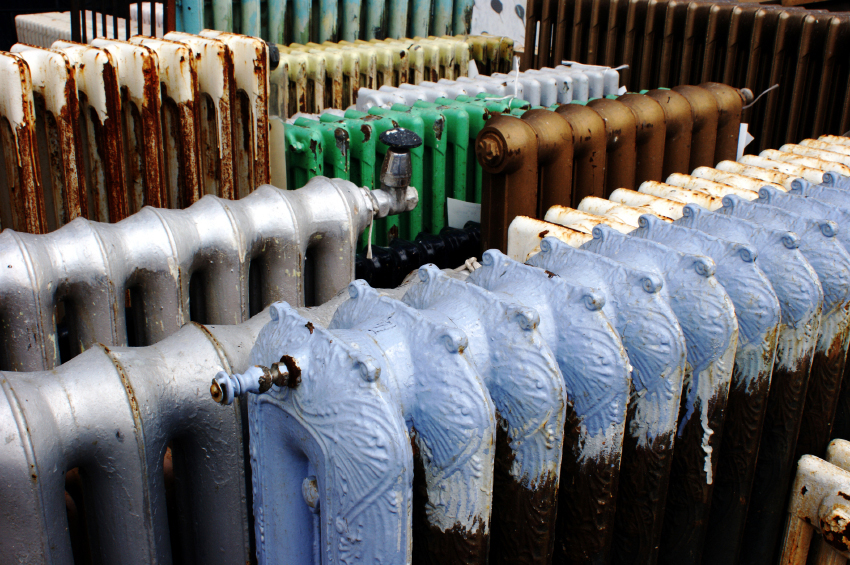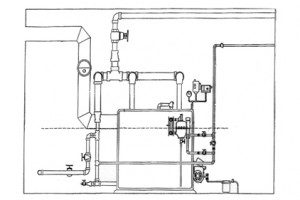We always have turkey for Thanksgiving. I mean who doesn’t? My job wasn’t to cook it, though; it was to eat it.
Metal Paints and Radiators

Ever wonder why the Dead Men painted so many of those old, free-standing, steam- and hot-water radiators silver? Yeah, so did I. I did some digging and came up with a delicious story for you. It goes like this.
At the turn of the 20th Century, radiators were mostly plain grey metal. Many of these were fancy, with gorgeous, Victorian-style decorations. Radiator manufacturers did this because central heating was new back then, and they wanted to make the radiators part of the room’s decor. That worked out well and the business grew.
But then, the Archduke Ferdinand’s procession through Sarajevo took a wrong turn and wound up going by a building where 19-year-old Gavrilo Princip happened to be leaning. The kid shot the Archduke and sowed the seeds for what was to become The Great War.
That happened on June 28, 1914. A wrong turn. Go figure.
Fast-forward to the winter of 1918 when the Spanish Influenza arrives and quickly morphs into a pandemic. The Spanish Flu ends the following year, but not before killing five percent of the world’s population. That’s far more than died in every war we’ve ever fought. Oh, and it began not in Spain but in Kansas at Camp Funston. Spain was neutral during the Great War and they were the first country to admit a pandemic was raging. Countries involved in the war didn’t want to mention this because it would give aid and comfort to their enemies. They just pretended the pandemic wasn’t happening, which was a dumb thing to do.
Anyway, The Great War ends and the Roaring Twenties begin, but because so many people feared a return of the Spanish Flu, the Board of Health in the U.S. decreed that people must leave their bedroom windows open. They figured fresh air will fight the flu. Americans liked this idea so much that they opened not only the bedroom windows but all the other windows. This, of course, presented a challenge to those practicing the relatively new art of central heating.
I noticed this for the first time years ago when I was reading engineering books from the 1920s and the authors were saying that designers needed to size the boilers and radiators for the coldest day of the year, with the wind howling, and with the windows open. Huh?
The authors didn’t explain why so I scratched my head and read more widely. That’s how I learned the rest of the story. And this is why those old radiators are so large. See? It pays to read books.
But then the Great Depression arrived in 1929 (Who knew?) and before long, Americans learned that it cost a lot to heat a house with the windows open. The Spanish flu never returned, so people looked at each other, shrugged, and closed the windows.
And that’s when they learned that their radiators could put out more heat than Shakira. People sat panting in their stuffy homes and apartments. In frustration, they appealed to their government to do something about this mess.
The solution arrived by way of a government report that spoke of the glories of metallic paint, mainly aluminum-bronzing paint. That also had me scratching my head for a while, so I read some more books.
It turns out that with a free-standing, cast-iron radiator about 70% of the heat will come off the radiator by way of convection. The air touches the hot metal and rises. Cold air takes it place and the Ferris wheel-like cycle of heating begins. That’s easy to understand. But the balance of the heat, fully 30% of the radiator’s output, arrives in the form of radiation, which we can’t see. It steams off the radiators and onto the people in the same way that sunlight does.
So I read more books and learned that there are two things that affect radiation: The first is the temperature of the radiator’s surface, and that’s easy to understand. But the second thing is a bit more mysterious. It’s called emissivity, and the emissivity of aluminum happens to be very low. The government tested a bunch of paints that contain aluminum flakes and they learned that if the outermost surface of the radiator is mainly aluminum flakes, the rate of radiation will drop drastically. And we’re not talking convection here. That stays at 70% of the total heat output, but the metallic paint will really chop into that last 30% of the radiator’s heat output.
A simple way to visualize this is to think about those shiny blankets that marathon runners use to stay warm when they finish a race. Those blankets allow your body’s radiant energy to stay near your body, and that’s why you feel warm when you’re wrapped in one.
The color of the paint also affects emissivity. We know that black radiates more than white. This is why they painted the SR-71 Blackbird black. It wasn’t for stealth. The Blackbird was the fastest plane ever built and it got so hot it glowed. The black paint was to dissipate some of that aerodynamic heat created when you fly at nearly 2,200 mph.
And in the same way, if a color is good at radiating heat, it’s also good at absorbing heat. This is why the inside of a black car will get a lot hotter during the summer than the inside of a white car. The same goes for a black roof. Some roofing companies like to use aluminum paint on tar roofs because the low-emissivity of the aluminum won’t absorb as much sunlight, and that increases the life of the roof.
Gold is a poor absorber of heat, and that’s why they use it on spacecraft. The less sunlight absorbed the better when you’re in space. Unless we’re talking solar panels of course (they’re all black, right?).
But back to that metallic paint on the radiators. The overall result of using aluminum-bronzing paint on an old radiator was that the radiator suddenly gave out 20% less Btuh than an unpainted radiator. And again, remember that we’re not talking about convection here; just radiation.
The U.S. Department of Commerce’s National Bureau of Standards published their report on July 19, 1935. You can read it here. The report advises people to use metallic paint on radiators, but only in the rooms that were overheating. They also suggested that folks paint the back of the radiators with metallic paint as a way of lessening the radiant-heat transfer to walls that were probably not insulated.
So that’s why the radiators are the color that they are. If you want to increase the Btuh output of the radiator, all you have to do is paint it again with a non-metallic paint. Sounds crazy, I know, but it’s true. It’s the final coat that makes all the difference.
Oh, and to make this story even more delicious, consider radiator covers. Those covers aren’t there to keep the kids from touching the hot radiators. Most kids will only do that once. No, those covers were there to tone-down the heat output of those Shakira-like radiators.
Visit old buildings and you’ll see these classic radiator covers. They have solid tops and metal front panels that have hundreds of holes to let the air in and out. It turns out that that solid top cripples air convection and reduces the radiator’s overall output by 30%.
So paint it with aluminum-bronze paint and you’ll reduce the output by 20%. And then drop one of those covers over it and you cut an additional 30% off the total. That’s how they reigned-in oversized radiators back in the day.
And to think all of this started because the Archduke’s procession took a wrong turn in Sarajevo.
Gosh.
Leave a comment
Related Posts
I had written a story for Plumbing & Mechanical a while back about a fella in Canada who sent me this email: "Our problem is that five out of hundreds of univentilator co...

I love all the advances taking place in the world of hydronics, but I’m still seeing plenty of steam systems out there in our older cities, so knowing about dry steam wil...